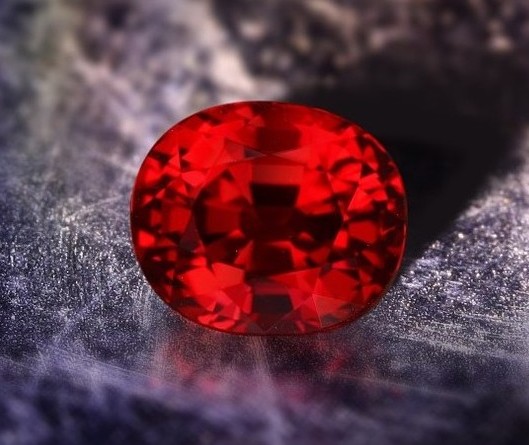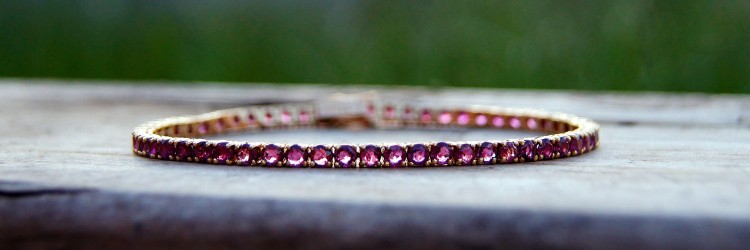Proverbs 31:10 says of a virtuous woman that “her value is far above rubies,” so we know that rubies then were as precious and costly as they are now. After the emerald, ruby is the most consistently expensive gemstone. Department stores do not carry real rubies of any value; their “genuine stones,” frequently set in gold-plated jewelry, are usually dull and opaque, the color of cough syrup. “Simulated” rubies might be scarlet or intensely colored like the red light in a traffic signal. Both represent the July birthstone, but these are not rubies of the kind the Bible mentions.
A ruby’s value depends on its transparency and a cherry or wine color. A blood-red ruby is called a “pigeon-blood” ruby, so rare that in 2015 a 25-carat specimen, called “The Sunrise Ruby,” at auction set the all-time record for colored gemstones, at $30 million. If you can’t afford a natural stone, seek not “simulated” rubies but “created” rubies, which means they are laboratory-grown and chemically identical to natural rubies. Then you have a stone with true power, and even more so if you were born in July.
Burma, Thailand, and Cambodia had the world’s richest ruby and sapphire mines, but between 1975 and 1979 Cambodian dictator Pol Pot enriched himself and his genocidal regime and destroyed the local economy by depleting them. Today, people pay $40 to hunt in that region for raw stones they might or might not find. Ruby can appear in the forms of crystals, streaks, and pebbles. Tiny crystals might be fused with another mineral of lesser value, as are the ruby streaks in green zoisite or in blue kyanite. This ruby cannot be dug out. Nonetheless the ruby in these minerals greatly enhances their metaphysical power.
Geologically, ruby and sapphire are family. Both are the same mineral, called corundum, but differ slightly in chemical content. Corundum is second only to diamond on the Mohs hardness scale, scoring a 9 out of 10, and both stones are thus excellent choices for rings.
Legends of the Ruby
Legends abound about fabulous rubies that glow in the dark like coals or turn night into day. Marco Polo was bowled over by the sight of a ruby “a palm in length and thick as a man’s arm,” owned by the King of Ceylon. Marco Polo reported that another king offered a whole city in exchange for this ruby. Saying that it was a family heirloom, the King of Ceylon wouldn’t sell.
Snake rings with rubies for eyes were inspired by the many legends about snakes and dragons with ruby eyes or rubies in the tops of their heads. Heroes and saints slew dragons not to rescue beautiful maidens—who were a dime a dozen—but to secure the rubies. Anyone lucky enough to own a ruby often had it engraved with the image of a snake or dragon, because this supposedly attracted wealth.

True stories about rubies are inevitably stories about the very rich. In 1968, Aristotle Onassis gave Jacqueline Kennedy Onassis a wedding gift of a 17.62-carat heart-shaped ruby surrounded by five carats of diamonds, and matching clip-style earrings. She kept the ring all her life. After her death, Sotheby’s auctioned it for $312,000. With today’s inflated prices it might well be sold for three times that or more. Most world-class rubies are not worn but disappear into private collections.
It’s not legend but true that a ruby can change its color when exposed to high heat; it then returns to its natural color. In the same way, according to superstition, if a ruby-wearer discerns a color change, it means he or she is in danger of being attacked physically or psychically. When the threat passes, the stone returns to its normal color.
The Powers of Ruby
Both ancient and modern sources agree that ruby is a good stone for anyone to have or carry. It supposedly draws wealth like a magnet and clings to it so that the wearer will never be poor. Ruby, being the color of healthy blood, is metaphysically a source of vigor, especially heart health. It’s the stone of sovereigns and winners, often associated with the regal zodiac sign Leo.
Fittingly, a huge red gem called “the Black Prince’s Ruby” is the principal stone in the crown of Great Britain’s crown jewels, proving that someone believed the ruby was a power stone. But this gem was later found to be red spinel rather than ruby.
According to the book Healing with Crystals and Gemstones, in healing rituals garnet can substitute for ruby. Wear a garnet as a placeholder until you save enough money for a ruby or for a red spinel. If red spinel is a good enough for Britain’s royalty, it’s good enough for anyone! Even a small ruby carries the aura of thousands of years of legends and tales—some of which must be true.
